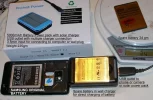johnsondav
New Member
- Time of past OR future Camino
- June 2014
Since we all walk many hours in the sun each day, does anyone have knowledge of a functional solar charger for phones or cameras?
| Remove ads on the forum by becoming a donating member. More here. |
|---|
does anyone have knowledge of a functional solar charger for phones or cameras
Tried out the solar charger on trip down through France. Result???
Rubbish - it does not charge up even in bright sunlight. Waste of weight.
The problem with solar chargers is that you need a lot of real estate for them to be efficient, and the ones that you hang on your pack simply aren't efficient due to their size and not worth carrying

The power pak will charge a camera battery as it comes with multi-adapter connectors, if you are serious in your photography and willing to carry the extra weight, see above, you can carry spare batteries as the small solar charger are meant to give a boost and not to be the main charger.I don't know about a camera though......probably need a larger capacity solar panel/cell
Why not charge up your electronics the night before you head out? GPS? On the Camino, a well marked trail system? I used Google maps to determine how far I had to go, it only frustrated me more by using it when I saw how many km's left I had to walk.
All these other gadgets just create unnecessary weight you don't need to carry, Spain is not a third world country, the Albergues have electrical outlets, some of the older Albergues have fewer outlets, just get a 2 or 3 way splitter and/or double USB charging plug and you'll be fine, your fellow pilgrims will appreciate it as well.
I carried an iPhone 5 with a Spanish data SIM card and charged it at end of the day when I got to the Albergue, it never dropped below 50%, I never used a mapping app (which suck down the battery) to track my distance covered, I knew how far I walked that day. If you are using a GPS/mapping app the entire day while you walk, then an external battery would be worth using.
The problem with solar chargers is that you need a lot of real estate for them to be efficient, and the ones that you hang on your pack simply aren't efficient due to their size and not worth carrying.
Perhaps for the same reason you are taking a tent; they want to.I'm still confused as to why someone would need a GPS
I bought a Waka Waka. But there are dozens. Now, if you buy a cheap Chinese one don't come back crying here.
This year we are further advanced with product development. WakaWaka Power is being developed in The Netherlands. Design for hard & software is done there. Engineering as well, in close cooperation with our manufacturing partner in China.
And what does a GPS do anyway...tell you where you are? You know where you are! Tell people how to find you...how can you be lost if you are on the Camino? Find Albergues? Whats not to find? just follow the pilgrims...ask...use your words! Why not trust your inner guides and your instinct to get you there? You are NOT going into the deep endless jungles of the Amazon or into the Rocky mountains or the great white north. You are following a well known path and even if you are not on a road you will always be near one and there are so many little places in between. I personally don't get it...but maybe thats the whole point...its your journey!
Stuart, it would be ungracious of me to wish upon you the misfortune of missing a waymark at some critical junction, at which point you might get a practical appreciation of just how arrogant your comment seems to one of those that have done that.If someone needed gps to navigate the Frances they probably shouldn't be out on their own. I cant recall a better marked hiking trail that I've been on. It's only a step off having a string between the start and SdC.
Since we all walk many hours in the sun each day, does anyone have knowledge of a functional solar charger for phones or cameras?


